Birds
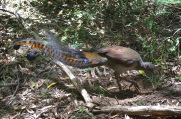
In Moist Forest In Deep Gullies
Deep gullies run from the Hawkesbury sandstone plateau down to the coastal beaches around Brisbane Water.
Low in these gullies is remnant rainforest vegetation, a haven for the fruit-eating rainforest birds, Green Catbird, Brown Pigeon, Wonga Pigeon, Satin and Regent Bowerbirds.
On the steep sides of the gullies Lyrebirds call and Brush-turkeys build their mounds, scratching for insects in the deep forest litter.
Deep gullies run from the Hawkesbury sandstone plateau down to the coastal beaches around Brisbane Water.
Low in these gullies is remnant rainforest vegetation, a haven for the fruit-eating rainforest birds, Green Catbird, Brown Pigeon, Wonga Pigeon, Satin and Regent Bowerbirds.
On the steep sides of the gullies Lyrebirds call and Brush-turkeys build their mounds, scratching for insects in the deep forest litter.
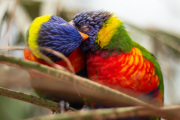
Birdlife in Woodland
Dry sclerophyll woodland. dominated by Eucalypts and Angophoras. covers the greater part of the Peninsula. There are two levels of vegetation. the taller trees above and an understorey of flowering shrubs and herbaceous plants below. This supports the greatest variety of bird species because of the range of feeding and nesting places.
Nectar, insects, fruit and seed provide feeding niches at different levels from the Lorikeets in the top blossom through Bellbirds, Thornbills and Pardalotes to Wrens in the lower shrubbery.
Dry sclerophyll woodland. dominated by Eucalypts and Angophoras. covers the greater part of the Peninsula. There are two levels of vegetation. the taller trees above and an understorey of flowering shrubs and herbaceous plants below. This supports the greatest variety of bird species because of the range of feeding and nesting places.
Nectar, insects, fruit and seed provide feeding niches at different levels from the Lorikeets in the top blossom through Bellbirds, Thornbills and Pardalotes to Wrens in the lower shrubbery.
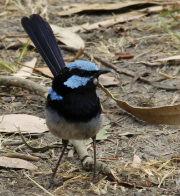
Heath
Facing seawards above the cliffs,are three heathlands. Bombi and Mourawaring Moors and the Box Head Heath. The first two are perched sand dunes and the third is on Hawkesbury Sandstone with many rock outcrops. All three carry a wide variety of stunted flowering shrubs dominated by Banksia, Casuarina, Hakea, Lambertia and Callistemon. This supports a large population of Honeyeaters mainly White-cheeked and New Holland and Little Wattlebirds. Other residents are Tawny-crowned Honeyeaters. Emu-wrens and Variegated Fairy-wrens.
The heaths are visited by many of the woodland birds including Spinebills, Grey Shrike-thrushes, Red-browed Firetails and passing migrants such as Rufous Whistlers and Yellow-faced Honeyeaters.
Facing seawards above the cliffs,are three heathlands. Bombi and Mourawaring Moors and the Box Head Heath. The first two are perched sand dunes and the third is on Hawkesbury Sandstone with many rock outcrops. All three carry a wide variety of stunted flowering shrubs dominated by Banksia, Casuarina, Hakea, Lambertia and Callistemon. This supports a large population of Honeyeaters mainly White-cheeked and New Holland and Little Wattlebirds. Other residents are Tawny-crowned Honeyeaters. Emu-wrens and Variegated Fairy-wrens.
The heaths are visited by many of the woodland birds including Spinebills, Grey Shrike-thrushes, Red-browed Firetails and passing migrants such as Rufous Whistlers and Yellow-faced Honeyeaters.
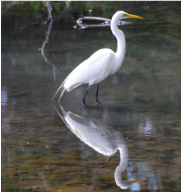
Estuarine Bays
In Rileys Bay, Hardys Bay and Empire Bay there is a succession from deep water through intertidal alluvial flats, mangroves, samphire and reeds to she-oaks. This produces food and roosting places for fishing birds, waders and smaller insectivorous birds. Egrets, plovers, curlews, heron
At times the population is greatly increased by the arrival of migrants and nomads such as Black Swans and Pelicans.
In Rileys Bay, Hardys Bay and Empire Bay there is a succession from deep water through intertidal alluvial flats, mangroves, samphire and reeds to she-oaks. This produces food and roosting places for fishing birds, waders and smaller insectivorous birds. Egrets, plovers, curlews, heron
At times the population is greatly increased by the arrival of migrants and nomads such as Black Swans and Pelicans.

Coastal Dune Scrubland and Lagoons
On recent sand dunes behind Putty Beach, Maitland Bay and MacMasters Beach are reedy lagoons and tall scrub dominated by Leptospermum, Melaleuca and Banksia.
Although considerably disturbed by human intrusion there is still a large population of smaller birds such as Honeyeaters, Wrens, Robins, Finches, Silvereyes and Thornbills.
On recent sand dunes behind Putty Beach, Maitland Bay and MacMasters Beach are reedy lagoons and tall scrub dominated by Leptospermum, Melaleuca and Banksia.
Although considerably disturbed by human intrusion there is still a large population of smaller birds such as Honeyeaters, Wrens, Robins, Finches, Silvereyes and Thornbills.
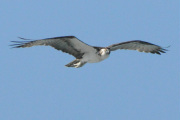
Marine Reserve and Shore
Bouddi National Park has many sandy coastal beaches, cliffs and rock platforms. The Marine Reserve covers a half kilometre seawards between Gerrin and Bombi Points. The most common birds are Silver Gulls, Crested Terns and Australasian Gannets.
Hundreds of Shearwaters pass on migration around the Pacific, and seen occasionally in the Reserve are Penguins, Albatrosses, Sooty Oystercatchers and White-bellied Sea-Eagles.
Bouddi National Park has many sandy coastal beaches, cliffs and rock platforms. The Marine Reserve covers a half kilometre seawards between Gerrin and Bombi Points. The most common birds are Silver Gulls, Crested Terns and Australasian Gannets.
Hundreds of Shearwaters pass on migration around the Pacific, and seen occasionally in the Reserve are Penguins, Albatrosses, Sooty Oystercatchers and White-bellied Sea-Eagles.

Residential Areas
More building with roads and clearing is bringing changes in the bird population. Some introduced birds - Starlings, Bulbuls, Turtledoves and Common Mynahs are extending thei r range to the southern part of the Peninsula to compete with the natives for food and nesting places.
Although losing their bush habitat, many of the Honeyeater group, Bowerbirds and Magpies are adapting to feed in domestic gardens. Grassed clearings bring more ground feeders, Mood Ducks, Finches and Galahs. Brown Pigeons and Regent Bowerbirds raid exotic fruit trees. There are roving bands of Lorikeets which visit houses for honey and Brush Turkeys come regularly for handouts.
More building with roads and clearing is bringing changes in the bird population. Some introduced birds - Starlings, Bulbuls, Turtledoves and Common Mynahs are extending thei r range to the southern part of the Peninsula to compete with the natives for food and nesting places.
Although losing their bush habitat, many of the Honeyeater group, Bowerbirds and Magpies are adapting to feed in domestic gardens. Grassed clearings bring more ground feeders, Mood Ducks, Finches and Galahs. Brown Pigeons and Regent Bowerbirds raid exotic fruit trees. There are roving bands of Lorikeets which visit houses for honey and Brush Turkeys come regularly for handouts.